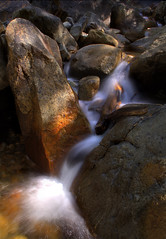Bronze Statue - Budapest (Winter/Spring 2003)

Well, my prediction came true, and today I feel a little like this guy. DOMS can continue to worsen for up to 48 hours after hard exercise or weight lifting. I also lightly twisted my ankle during said soccer matches, but I don't believe it was sprained.
However, with the number of people who do have problems with sprains, or muscle strains, here is my clinical advice:
RICE = Rest, Ice, Compression, Elevation
You want to use ice for the first 48-72 hours after an injury (the acute phase) and then once the injury is in either the subacute or chronic phase you can use heat.
Ice decreases blood flow to the tissue and decreases metabolism in the cells. The reason this is important in the acute phase of injuries is because you can get what is called "secondary cell hypoxia." This is where the injured tissue naturally increases its own metabolism to a point where it simply can't get enough oxygen delivered to it to sustain itself. Therefore the tissue dies, or is further damaged, which obviously is a problem.
So, in order to prevent further injury after an initial injury, ice is needed to cut the level of metabolism down to manageable levels. Heat is terrible to use initially, as the Russian athletic program demonstrated, because it further increases metabolism, but doesn't increase blood flow and oxygen levels enough to compensate for the already increased use of vital resources by the cells. After a few days (48-72hrs), the cells calm down and stop gulping oxygen like it's going out of style.
Then you want the injured tissue to heal. Heat increases blood flow and metabolism. Therefore, you use heat to increase the blood flow to injured tissue after it's stopped panicing. This will speed up the healing process.
Basically, if your injury is old, you use heat, if it's new, you use ice. If the pain doesn't get better over time, you see a physical therapist (or a doctor, who will most likely send you to a physical therapist eventually) to find out what you're doing wrong.
Guidelines for ice application:
You will feel 4 distinct sensations when applying ice to tissue. The first is an intense cold, followed by burning/stinging, which is followed by dull aching, which in turn is followed by complete numbness in the region.
You're going for numbness when applying ice because that is the point where you can't feel the pain, and you'll know that metabolism has been sufficiently decreased. Depending on how you're applying the ice, this stage can take from 15-30 minutes to reach. Twenty minutes is a good guideline to go by, but basically you can, and probably should, remove the ice as soon as you feel numb.




3 Comments:
I actually wanted to talk with you sometime about climbing injuries. It's something that every climber should know about. Most common is rotator-cuff injury. I've had this a few times, but now that I do a lot of push-ups (opposing muscles) after climbing, it hasn't happened again. However, what is your opinion of hot/cold treatment? Is there really some advantage to subjecting injured tissue to alternating extreme heat and then extremem cold?
Well, there can be, but it depends on what point in the healing cycle you do it. I need to look up that information, as I don't remember it off the top of my head.
Thanks Lisa. :)
Tim - As far as the alternating hot/cold treatment goes, I'd recommend just going with hot after 2 or 3 days of icing an injury. We haven't really covered the theory of contrast temperature application, and as far as I can tell there's not really any scientific evidence to support it. Basically, once you've gotten past the acute phase, you want to increase bloodflow to an injury as much as possible in order to increase the metabolism and speed the healing process. Heat does that, it also causes hemoglobin to give up its molecules of oxygen more readily, and it inhibits the firing of certain nerves that transmit pain signals.
Post a Comment
<< Home